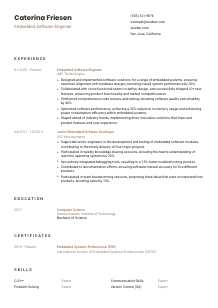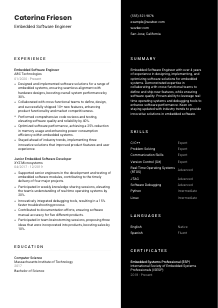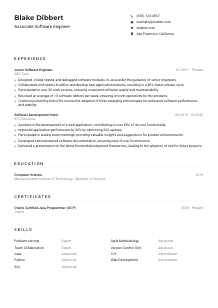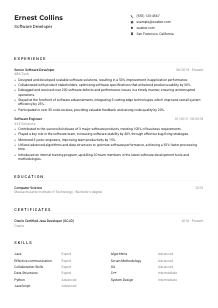Embedded Software Engineer CV Example
Cracking code, but your CV seems encrypted? Dive into this Embedded Software Engineer CV example, decrypted with Wozber free CV builder. See how effortlessly you can translate your firmware finesse to sync with job provisions, making your career journey as smooth as a flash memory write!

How to write an Embedded Software Engineer CV?
Ah, the journey of an Embedded Software Engineer - a blend of innovation, constant learning, and pushing boundaries in the tech realm. Whether you're a seasoned pro or eagerly eyeing that first big break, your CV is your passport. But not just any CV. One that harmoniously syncs with the pulse of desired job roles, impresses with its adherence to ATS compliance, and stands as a testament to your prowess.
Let's gear up to sculpt a CV using Wozber that responds directly to your dream job's call. As we turn each requirement into a beacon that guides your content, remember, this isn't just about landing a job; it's about setting the stage for your career's next big leap.
Personal Details
First impressions in the job market are digital, and your personal details are the handshake before the virtual meet. Perfecting this section for an Embedded Software Engineer means precision and relevance. Dive into tailoring it to ensure you're seen, heard, and remembered.
1. Your Name: Your Code Signature
Let your name be the first command that catches the eye. Opt for a legible, slightly amplified font size - it's you as the reliable function in a crucial codebase. Every detail counts, from avoiding playful email addresses to making sure your location aligns with the job's geography, as in `"San Jose, California"`. This attentiveness signals your grounded readiness for the role.
2. Job Title Compatibility
Under your name, proudly display the role you're vying for - 'Embedded Software Engineer'. This isn't just a title; it's an assertion of your identity within the tech universe. It instantly aligns your aspirations with the job, speaking volumes to the hiring manager scanning through piles of CVs.
3. Channels of Communication
Keep your phone number typo-free and your email professional. A pro tip? Format your email as `firstname.lastname@email.com` - it's akin to declaring a variable in your code, easy to interpret and error-free. This ensures you're reachable without friction or queries.
4. Geo-Tagging
By highlighting 'San Jose, California', you're not just stating your location; you're reaffirming your availability and fittingness for the role. It tells the employer you're in sync with the logistic prerequisites of the job, reducing barriers to your potential onboard.
5. Digital Presence
Consider adding your LinkedIn or GitHub profile, ensuring they mirror your CV's professionalism. It's your digital workspace and portfolio rolled into one, offering a deeper insight into your coding victories and collaborative projects.
Takeaway
Your personal details, presented thoughtfully, set a professional and aligned tone for the rest of your CV. It's your first opportunity to demonstrate precision, attention to detail, and a nod to professional etiquette. Make every character count.





Experience
Showcasing your professional journey is where your CV starts to compile the story of your capabilities. For an Embedded Software Engineer, this section is about proving your mettle through specific achievements and contributions. Let's map out how to construct this narrative to resonate with your next role's expectations.
- Designed and implemented software solutions for a range of embedded systems, ensuring seamless alignment with hardware designs, boosting overall system performance by 30%.
- Collaborated with cross‑functional teams to define, design, and successfully shipped 10+ new features, enhancing product functionality and market competitiveness.
- Performed comprehensive code reviews and testing, elevating software quality and reliability by 40%.
- Optimised software performance, achieving a 25% reduction in memory usage and enhancing power consumption efficiency within embedded systems.
- Stayed ahead of industry trends, implementing three innovative solutions that improved product features and user experience.
- Supported senior engineers in the development and testing of embedded software modules, contributing to the timely delivery of four major projects.
- Participated in weekly knowledge sharing sessions, elevating the team's understanding of real‑time operating systems by 20%.
- Innovatively integrated debugging tools, resulting in a 15% faster troubleshooting process.
- Contributed to documentation efforts, ensuring software manual accuracy for five different products.
- Participated in team brainstorming sessions, proposing three ideas that were incorporated into products, boosting sales by 10%.
1. Deciphering the Blueprint
Begin with a methodical breakdown of the job description. Highlight keywords and responsibilities like 'design and implement software solutions for embedded systems', then parallel them with your accomplishments. This meticulous mapping ensures a customized, relevant CV.
2. Role and Realm
Position each role with delineation - your title, the company's name, and your tenure. This structure is like arranging your code in readable segments, making it effortless for hiring managers to traverse your professional path.
3. Achievement Algorithms
Instead of a generic job description, quantify your successes. Did you enhance system performance by 30%? Detail these victories with numbers and outcomes, embodying the impact of your code in the real world. It turns your experience into proof of your expertise.
4. Performance Parameters
Numbers tell a story. They provide a measurable context to your contributions, whether it's reducing memory usage by 25% or amplifying software reliability by 40%. Such metrics invite the reader into the tangible realm of your achievements.
5. Relevance Over Repertoire
Filter your experience to spotlight roles and projects that speak to the Embedded Software Engineer's responsibilities. It's about quality, not quantity. Align your narrative with the job at hand, ensuring every sentence reinforces your candidacy.
Takeaway
Your experience section is the compiler of your CV, translating your professional journey into a robust case for your suitability. Tailor it meticulously, infusing it with the metrics and specifics that bring your contributions to life. Think of it as debugging your way to a flawless outcome.
Education
For an Embedded Software Engineer, the education section lays down the foundational protocols of your knowledge. It's not just about where you went to school; it's a testament to the rigor and relevance of your academic journey. Let's structure it to underline your fit for this role.
1. Targeted Academic Credentials
Zero in on the education requirements from the job description. In our case, a 'Bachelor's degree in Computer Science, Electrical Engineering, or related field' is the prerequisite. Your degree should not just be listed; it should resonate with the desired qualifications.
2. Structured Layout
Organize your academic details clearly - your degree, the institution, and your graduation year. This clarity presents your educational background as both comprehensive and relevant, making it easy for recruiters to see you've got the theoretical groundwork covered.
3. Degree-Specific Display
If the job asks specifically for a Computer Science degree, and that's what you have, then state it plainly. This exact match signals to the hiring manager that you possess the foundational knowledge required to thrive in this role.
4. Coursework and Projects
Although not always necessary, mentioning relevant courses or projects can bolster your claim to the job, particularly if you're early in your career. It's like adding comments to your code - offering insights into your learning and problem-solving process.
5. Extra Credits
Graduating with honors, contributing to relevant extracurriculars, or completing impactful projects can further accentuate your preparedness for the role. However, gauge the level of detail needed based on your career stage.
Takeaway
Your education section underlines the theoretical bedrock of your expertise. Presented effectively, it reassures employers of your qualifications and readiness to tackle the complexities of embedded software engineering. Make it a strong pillar of your CV.
Certificates
In the ever-evolving field of embedded software engineering, certifications act as badges of your ongoing commitment to growth and expertise. They can set you apart, showcasing your dedication to excelling in your sphere. Here's how to make this section deliver a powerful message.
1. Mapping to Job Needs
Since our example doesn't specify required certifications, focus on what enhances your profile. A certificate in 'Embedded Systems Professional (ESP)' directly ties into the job's core, showcasing your continued effort to specialize.
2. Selective Showcase
Highlight the certifications most relevant to the Embedded Software Engineer position. This quality-over-quantity approach ensures the reader views you as a specialized candidate, not just an enthusiast collecting accolades.
3. Date and Detail
Include acquisition dates, especially for industry-standard certifications, to show that your skills are fresh and up-to-date. It indicates that you're in step with the latest developments in a swiftly changing field.
4. Pursue Pertinence
Keep seeking certifications that align with your career trajectory. An ongoing learning mindset is invaluable in technology fields, indicative of a professional who doesn't just adapt to changes but embraces them.
Takeaway
Your certifications are a testament to your expertise and dedication to stay ahead in the fast-paced world of embedded software engineering. Curate this section to reflect your specialization and readiness to contribute at the highest level.
Skills
In embedded software engineering, your skills section is your professional syntax - the language through which you communicate your technical prowess and soft skill adeptness. Crafting this part with precision can significantly bolster your candidacy.
1. Extracting Keywords
Dissect the job description, identifying both the stated and implied skills. Words like 'proficiency in C/C++', 'real-time operating systems (RTOS)', and 'excellent problem-solving and communication skills' are your keywords. This tailored approach ensures ATS optimisation.
2. Prioritizing Proficiencies
such as problem-solving and communication.
3. Clarity and Impact
Keep this section organized and focused. Instead of inundating with every skill you possess, choose the ones that best match the job description. This not only makes your CV ATS-friendly but also immediately shows the hiring manager you're a fit.
Takeaway
Your skills section is a curated list that speaks volumes about your capability to fulfill the role's requirements. Approach it strategically, ensuring each skill listed underscores your suitability and readiness for the Embedded Software Engineer position.
Languages
In a global tech environment, your ability to navigate through multiple languages can be a significant asset, adding depth to your professional profile. Let's decode how to present your linguistic skills to highlight versatility and adaptability.
1. Aligning with Job Specifications
Given the demand for fluency in English, prioritize this language at the top of your section, ensuring your proficiency level is clear. This adherence to the requirement conveys your attentiveness to detail and readiness to communicate effectively.
2. Layering Your Linguistic Landscape
Even if additional languages aren't specified, list them to showcase your cultural adaptability and potential in engaging with diverse teams or markets. It's an added layer of capability that can distinguish you in a competitive field.
3. Honest Proficiency
Articulate your fluency with clarity, whether you're 'Native' in English or 'Fluent' in Spanish. This honesty not only builds trust but also gives a glimpse into your potential for global communication and collaboration.
4. Scope of the Role
Especially for roles with a global outreach or in multicultural teams, your language skills can be a unique selling point. Even if not explicitly required, they signal your ability to thrive in diverse working environments.
Takeaway
Your proficiency in languages is more than just a personal skill; it's a bridge to the world. By showcasing your linguistic abilities, you highlight your readiness for global challenges and opportunities in embedded software engineering.
Summary
The summary is where your narrative begins, setting the tone for your application. A compelling summary sharpens your CV's focus, weaving your key qualifications, skills, and aspirations into a narrative that grips the reader's attention.
1. Decoding the Core
Start by internalizing the core requirements of the job. Understand what makes an Embedded Software Engineer stand out - is it the proficiency in specific programming languages, or perhaps, a knack for otimizing software performance?
2. Opening Lines
Introduce yourself professionally, highlighting over 4 years of experience in embedded software development. This sets the stage, piquing interest in your journey and asserting your place in the landscape.
3. Underlining Achievements
Mention key skills and achievements like 'designed and implemented solutions, boosting system performance by 30%'. It's a snapshot of your impact, hinting at the depth of your capabilities.
4. Conciseness is Key
Keep your summary succinct, packing a punch in 3-5 lines. It's about giving a flavor of your professional essence without revealing the entire recipe. This teaser invites the reader to delve deeper into the narrative that unfolds in your CV.
Takeaway
Your summary is more than an introduction; it's your handshake from afar, the first pitch of your professional story. Craft it with intent, making it a compelling invite into the chapters of your career. It's the preamble to your prowess, setting the stage for what's to follow.
Embarking on Your Embedded Software Engineer Journey
You've meticulously crafted each section, translating job requirements into the language of your achievements and aspirations. Now, with insights in tow and Wozber by your side, you're ready to embark on the next phase of your career. Your CV isn't just a document; it's your story, a narrative of your growth, dedication, and potential. Align it with your dreams, refine it with your experiences, and let it be the beacon that guides you to opportunities abound.
The realm of embedded software engineering awaits your expertise. Go forth and conquer!

- Bachelor's degree in Computer Science, Electrical Engineering, or related field.
- Minimum of 3 years of experience in embedded software development.
- Proficiency in programming languages such as C/C++, with a strong understanding of real-time operating systems (RTOS).
- Familiarity with hardware-level integration and debugging tools (e.g., JTAG, oscilloscopes).
- Excellent problem-solving and communication skills.
- The position demands fluency in English.
- Must be located in San Jose, CA.
- Design and implement software solutions for embedded systems ensuring alignment with hardware design and application requirements.
- Collaborate with cross-functional teams to define, design, and ship new features or enhancements.
- Perform code reviews, testing, and debugging to ensure software quality and reliability.
- Optimize software performance, memory usage, and power consumption within embedded systems.
- Stay updated with the latest industry trends and technologies to provide innovative solutions.















